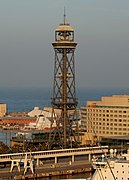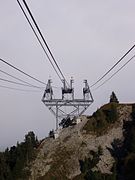
Cable transport is a broad class of transport modes that have cables. They transport passengers and goods, often in vehicles called cable cars. The cable may be driven or passive, and items may be moved by pulling, sliding, sailing, or by drives within the object being moved on cableways. The use of pulleys and balancing of loads moving up and down are common elements of cable transport. They are often used in mountainous areas where cable haulage can overcome large differences in elevation.

An aerial tramway, aerial tram, sky tram, aerial cablecar, aerial cableway, telepherique, or seilbahn is a type of aerial lift which uses one or two stationary ropes for support while a third moving rope provides propulsion. With this form of lift, the grip of an aerial tramway cabin is fixed onto the propulsion rope and cannot be decoupled from it during operations. In comparison to gondola lifts, aerial tramways generally provide lower line capacities and higher wait times.

A gondola lift is a means of cable transport and type of aerial lift which is supported and propelled by cables from above. It consists of a loop of steel wire rope that is strung between two stations, sometimes over intermediate supporting towers. The cable is driven by a bullwheel in a terminal, which is typically connected to an engine or electric motor. It is often considered a continuous system since it features a haul rope which continuously moves and circulates around two terminal stations. In contrast, an aerial tramway operates solely with fixed grips and simply shuttles back and forth between two end terminals.

An elevated passenger ropeway, or chairlift, is a type of aerial lift, which consists of a continuously circulating steel wire rope loop strung between two end terminals and usually over intermediate towers, carrying a series of chairs. They are the primary onhill transport at most ski areas, but are also found at amusement parks and various tourist attractions.

A funitel is a type of cableway, generally used to transport skiers, although at least one is used to transport finished cars between different areas of a factory. It differs from a standard gondola lift through the use of two arms attached to two parallel overhead cables, providing more stability in high winds. The name funitel is a portmanteau of the French words funiculaire and telepherique.
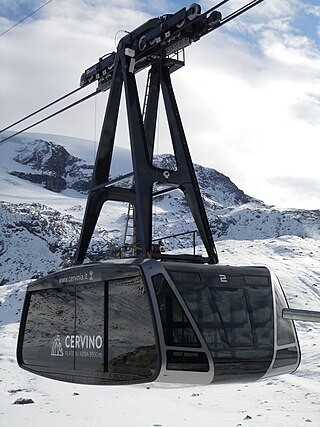
An aerial lift, also known as a cable car or ropeway, is a means of cable transport in which cabins, cars, gondolas, or open chairs are hauled above the ground by means of one or more cables. Aerial lift systems are frequently employed in a mountainous territory where roads are relatively difficult to build and use, and have seen extensive use in mining. Aerial lift systems are relatively easy to move and have been used to cross rivers and ravines. In more recent times, the cost-effectiveness and flexibility of aerial lifts have seen an increase of gondola lift being integrated into urban public transport systems.
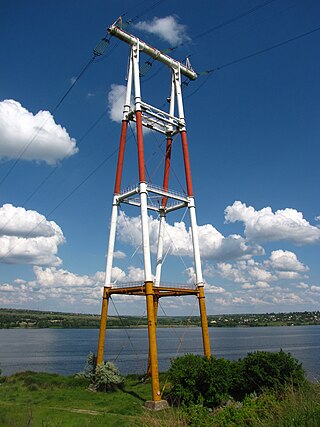
An overhead line crossing is the crossing of an obstacle—such as a traffic route, a river, a valley or a strait—by an overhead power line. The style of crossing depends on the local conditions and regulations at the time the power line is constructed. Overhead line crossings can sometimes require extensive construction and can also have operational issues. In such cases, those in charge of construction should consider whether a crossing of the obstacle would be better accomplished by an underground or submarine cable.
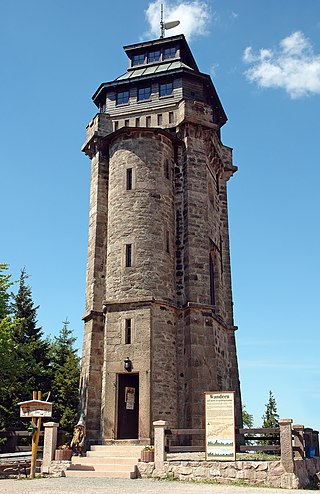
An observation tower is a structure used to view events from a long distance and to create a full 360 degree range of vision to conduct long distance observations. Observation towers are usually at least 20 metres (66 ft) tall and are made from stone, iron, and wood. Many modern towers are also used as TV towers, restaurants, or churches. The towers first appeared in the ancient world, as long ago as the Babylonian Empire.

The Seilbahn Zugspitze is an aerial tramway running from the Eibsee Lake to the top of Zugspitze in Bavaria, Germany. It currently holds the world record for the longest freespan in a cable car at 3,213 metres (10,541 ft) as well as the tallest lattice steel aerial tramway support tower in the world at 127 metres (417 ft). Construction of the system began in 2015 and it opened on 22 December 2017.
The Gant-Hohtälli Aerial Tramway is a large-cab cable car near Zermatt, Switzerland. It is 2,707 metres (8,881 ft) long and spans an elevation of some 1,057 metres (3,468 ft). This cable car is notable in that it runs over the tallest aerial lift pylon in Switzerland, with a height of 94 metres (308 ft).

The Glacial Aerial Tramway Kaprun III is the third section of the aerial tramway on the Kitzsteinhorn mountain at Kaprun, Austria. It was placed in service on 26 November 1966. It is currently branded Gipfelbahn.

Norsjö aerial tramway is a 13.2 kilometre long aerial tramway between Örträsk and Mensträsk in the Norsjö Municipality in Sweden.

The tricable gondola lift, also known as the 3S gondola lift, is a cable car system that was developed by the Swiss company Von Roll transport systems in Thun to unite the benefits of a gondola lift with those of a reversible cable car system. '3S' is an abbreviation of the German word dreiseil, meaning 'tricable'.

The Port Vell Aerial Tramway is an aerial tramway in Barcelona, Catalonia, Spain. It crosses Port Vell, Barcelona's old harbour, connecting the Montjuïc hill with the seaside suburb of Barceloneta.

The Eyüp Gondola, a.k.a. Eyüp–Piyerloti Aerial Cable Car, is a two-station gondola-type line of aerial lift passenger transport system located in Eyüp district of Istanbul, Turkey. Opened on November 30, 2005, the 420 m (1,380 ft) long line serves the Piyerloti Hill from Eyüp at the coast of Golden Horn. It is operated under the line number Tf2 by Istanbul Transport Company, a subsidiary of Istanbul Metropolitan Municipality. The fare is paid by the contactless smart card of Istanbulkart, which is valid at all public transport in Istanbul.
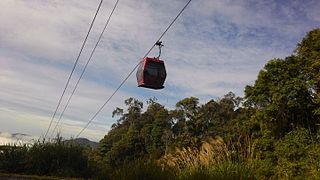
The Awana Skyway, also referred to as the new Awana Skyway, is a gondola lift system connecting Awana Transport Hub, Chin Swee Temple and SkyAvenue in Genting Highlands, Pahang, Malaysia since December 2016. The Awana Transport Hub terminus consists of the new Awana Bus Terminal, the station building and a new 8-storey car park while the other terminus is located at SkyAvenue.

The Aerial tramway, also known as Aerial lift or Aerial ropeway and cable car popularly known as ropeway in India, is a public transportation system where cabins, gondolas or open chairs are hauled above the ground with the help of cables. They are usually built in mountainous areas where it is difficult to build roads or railway.



